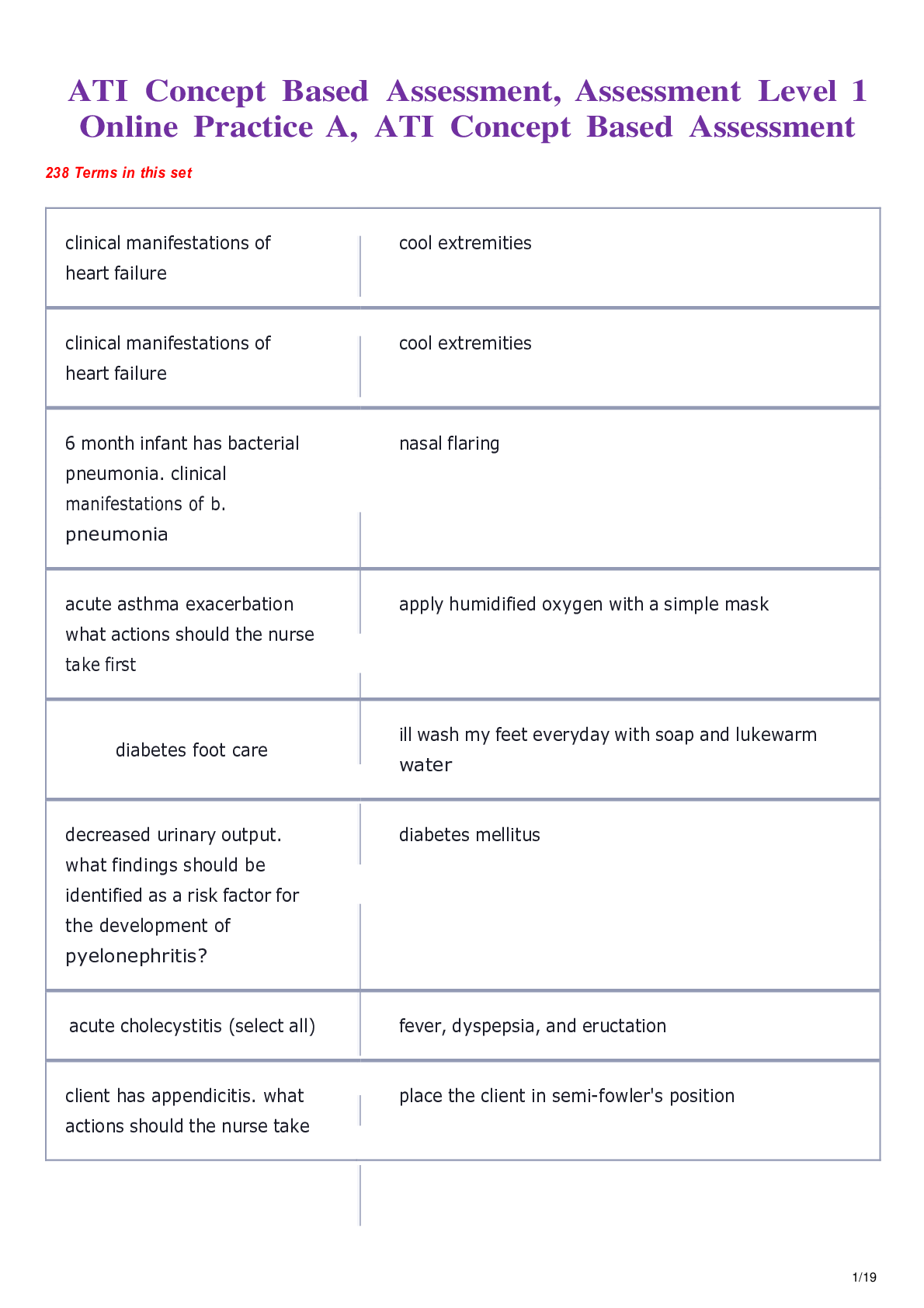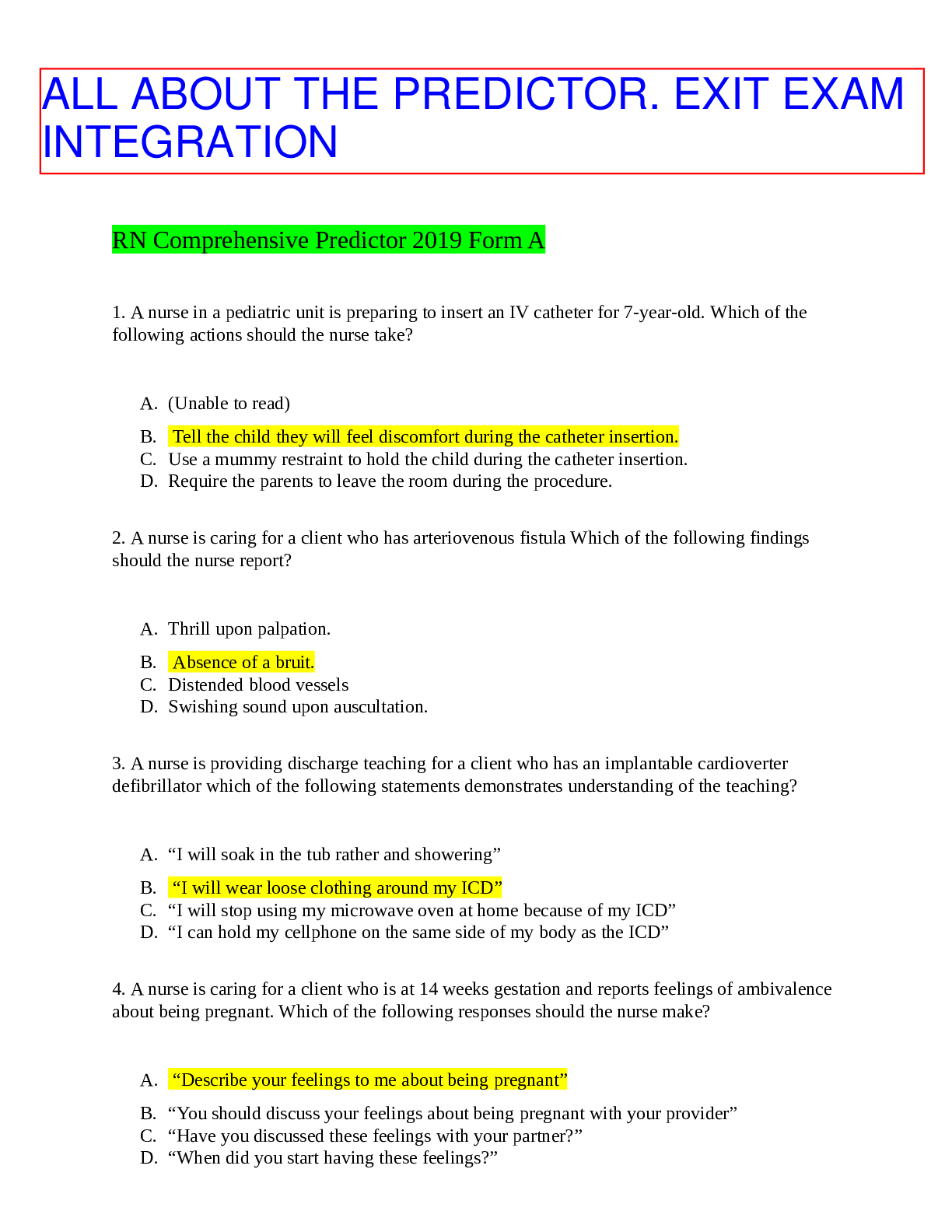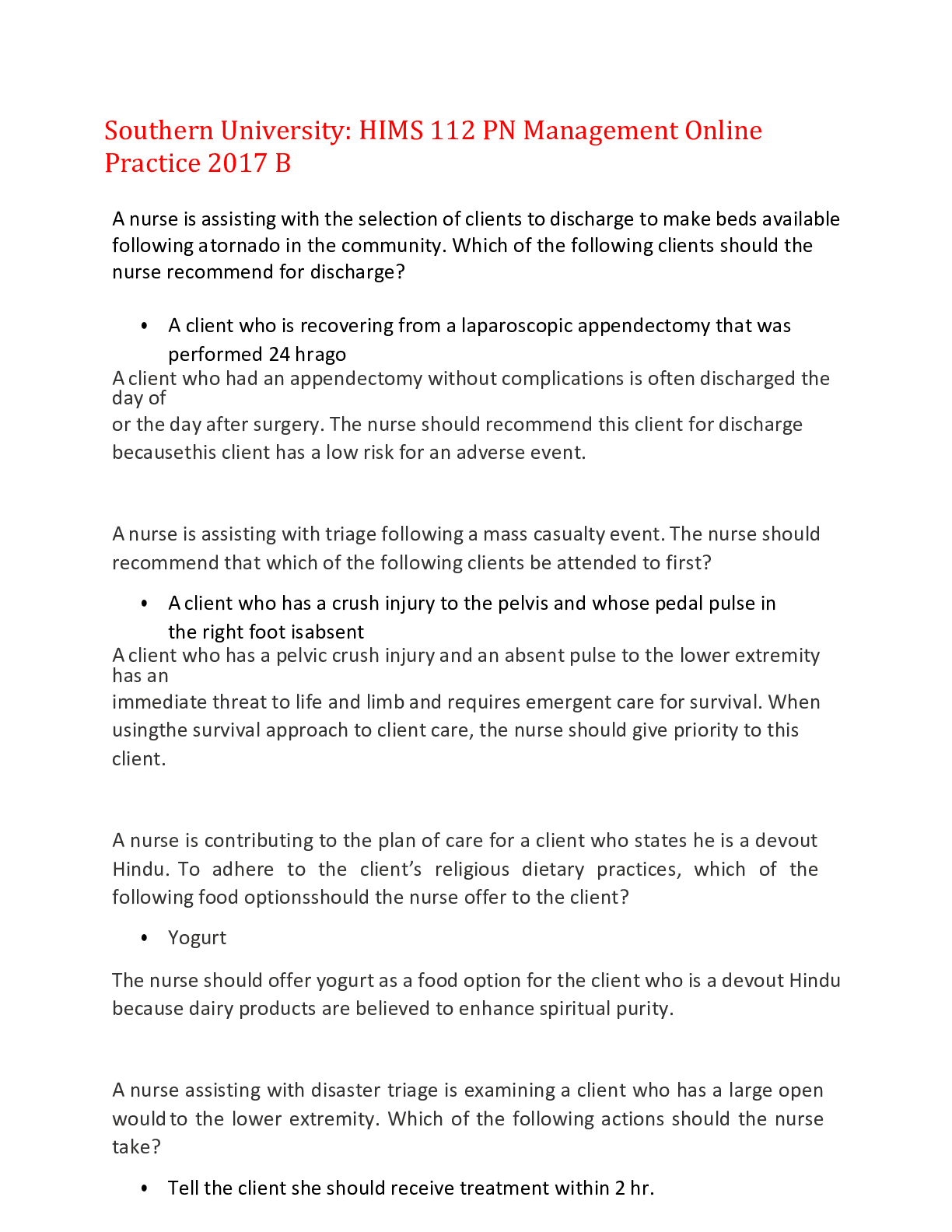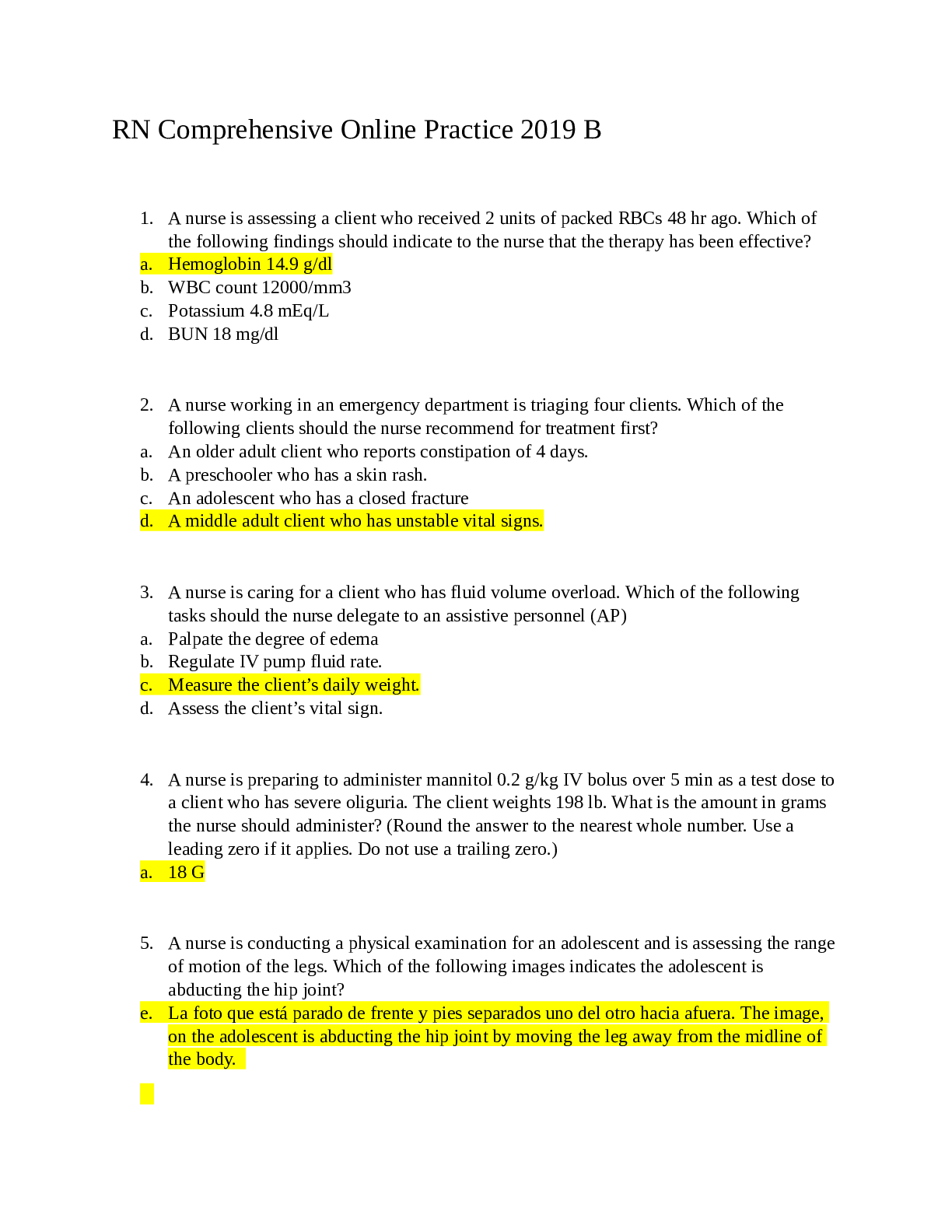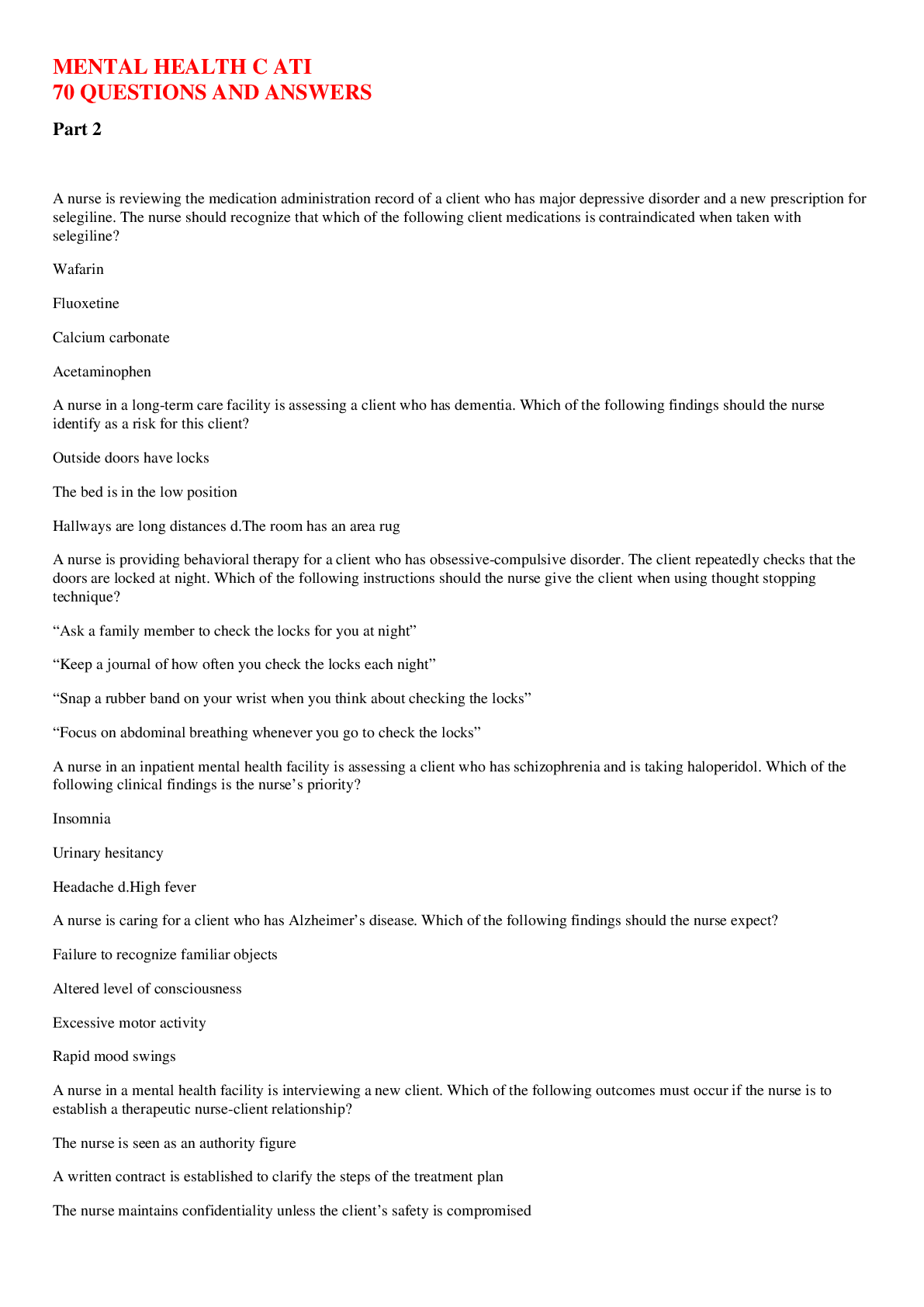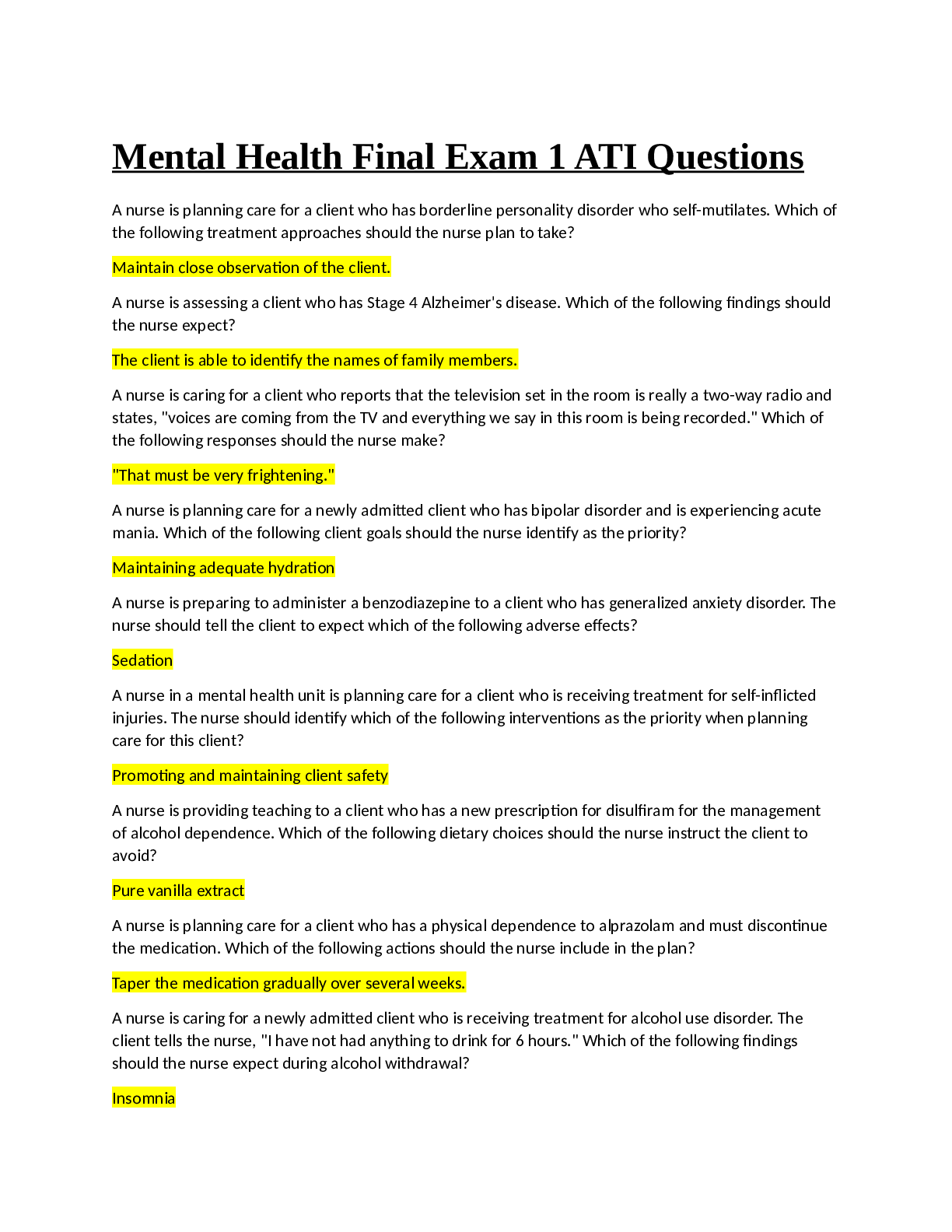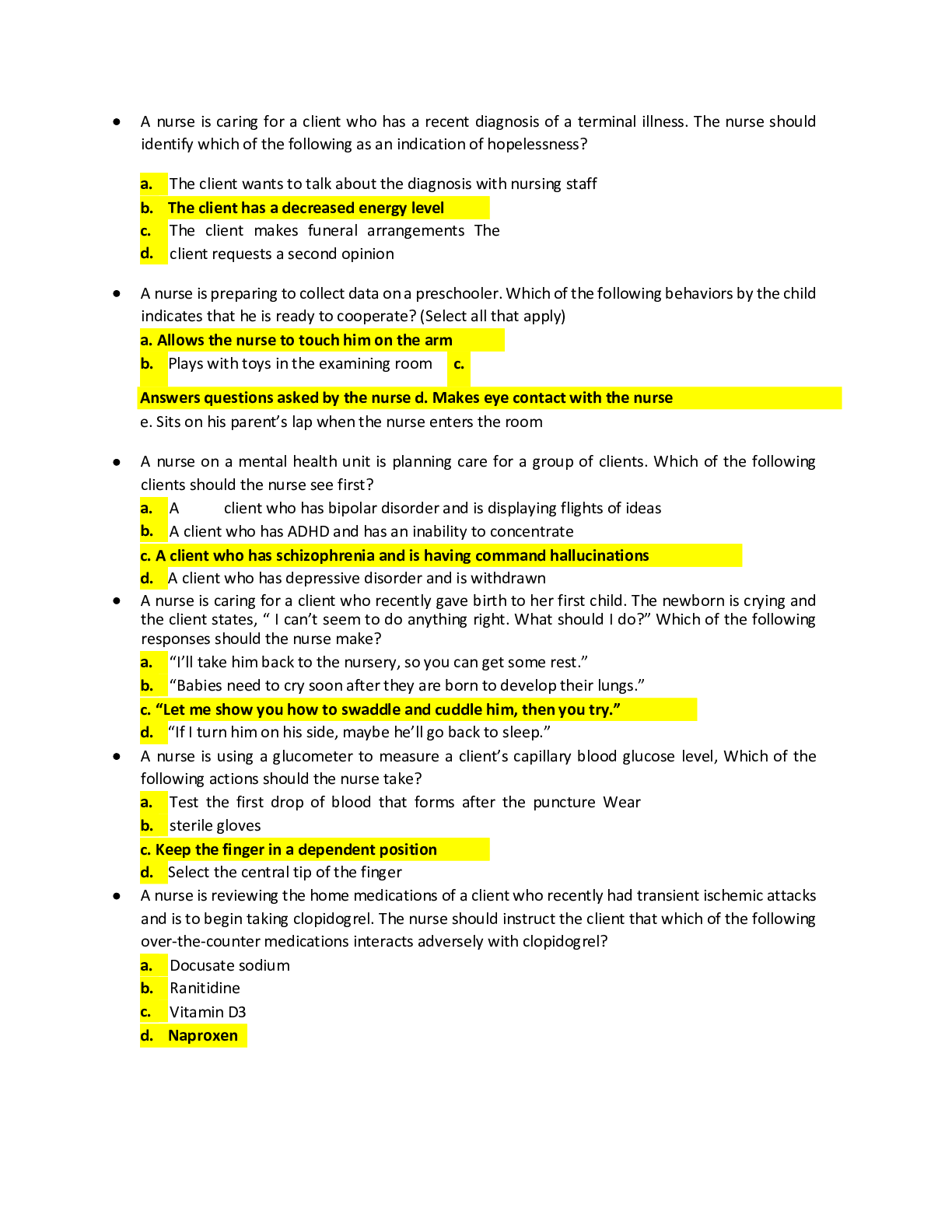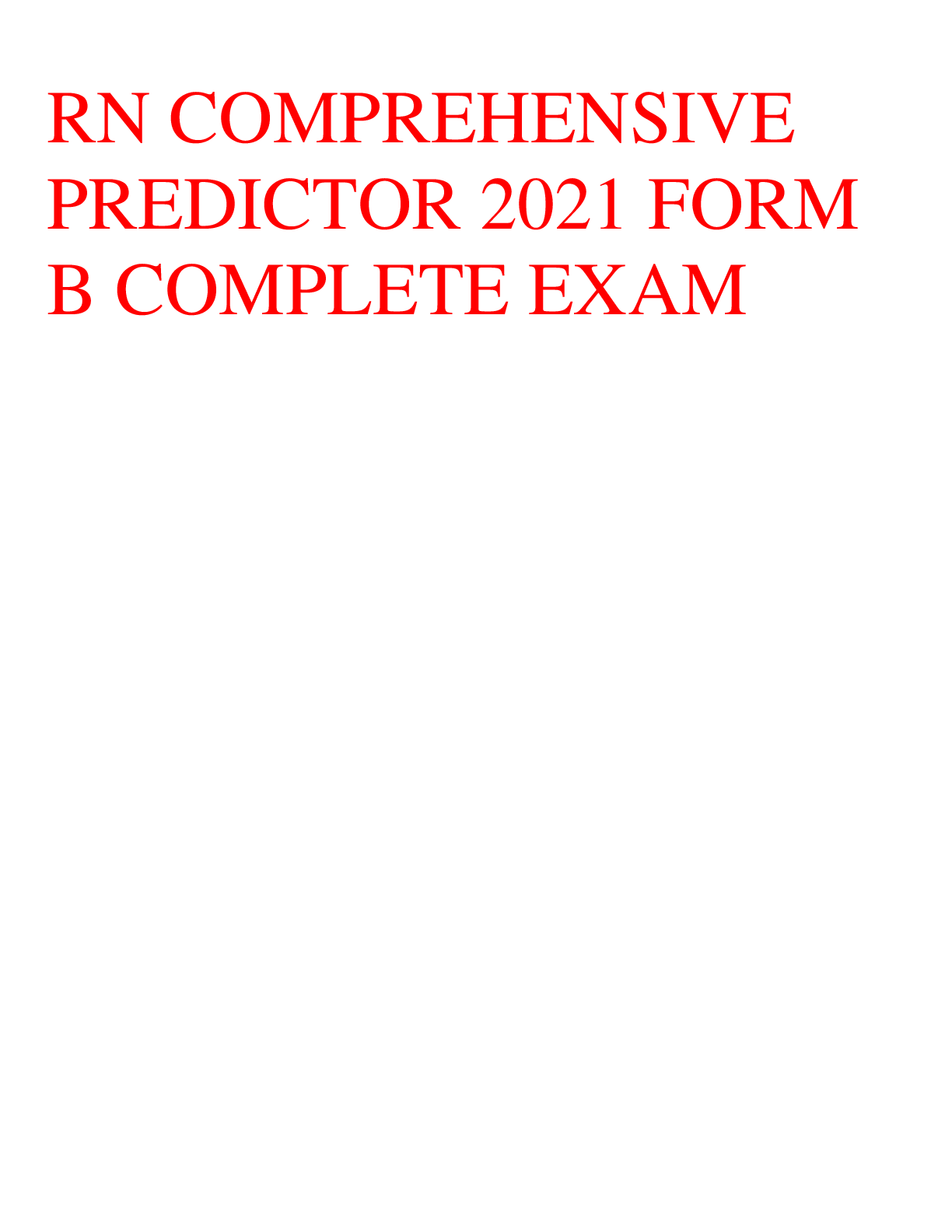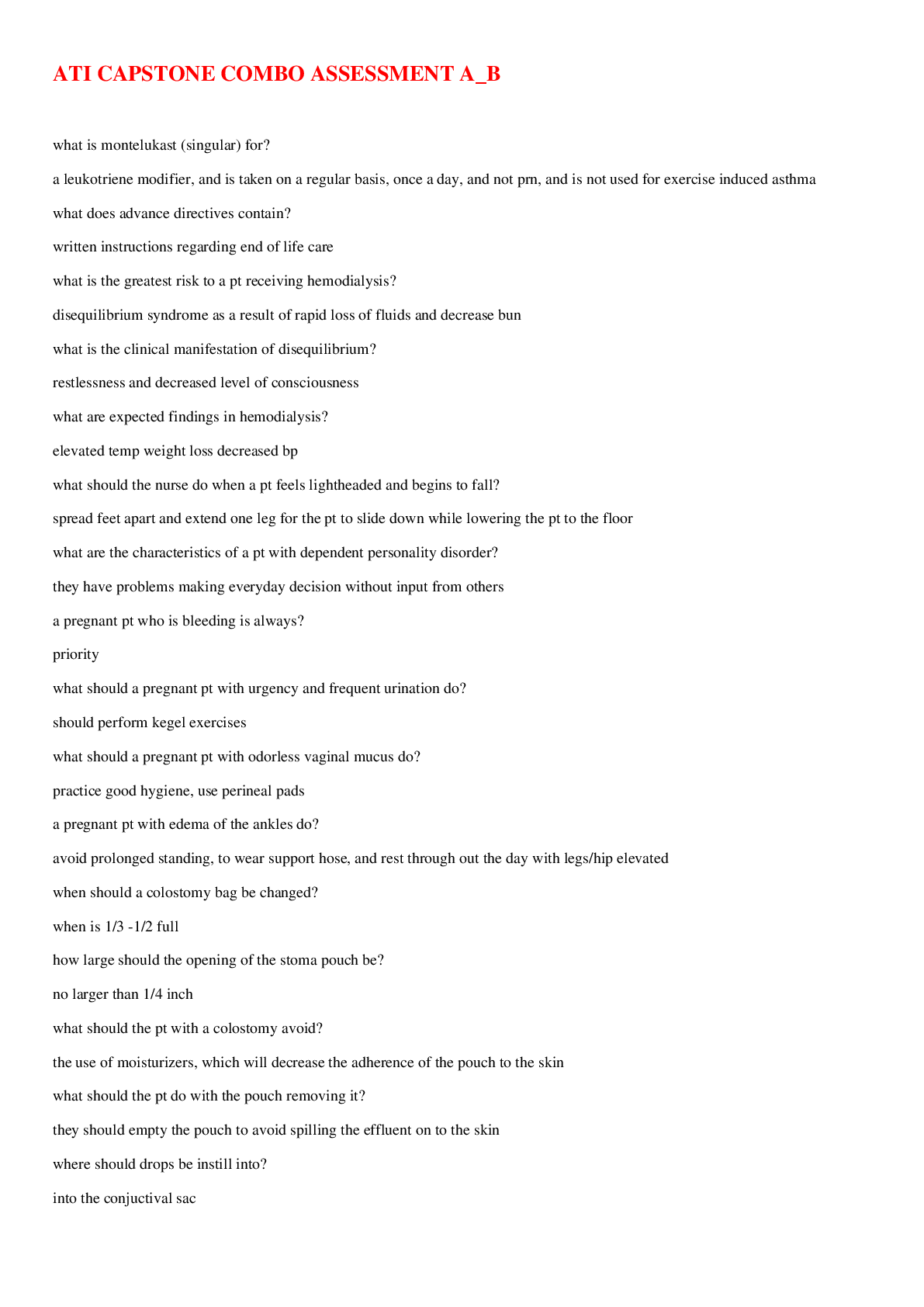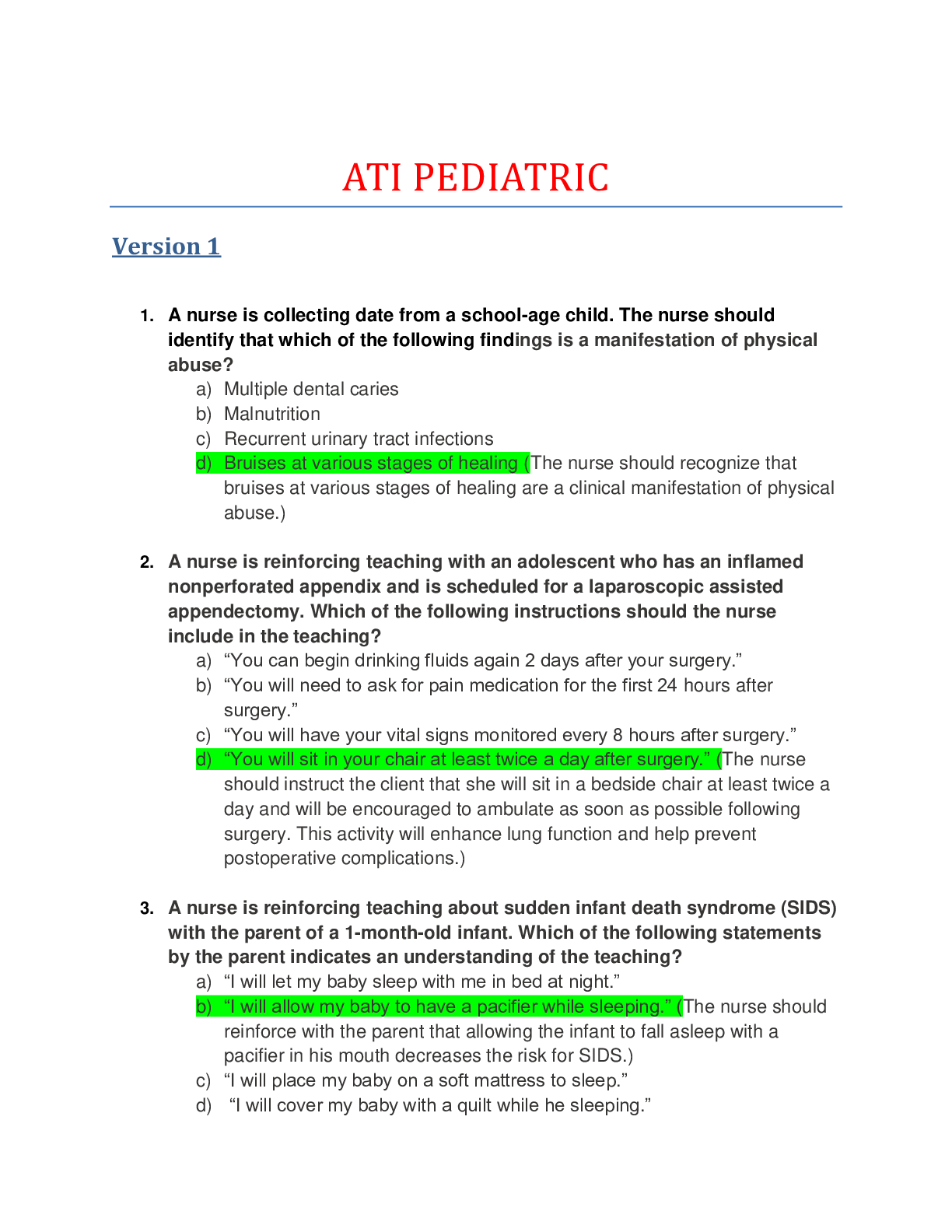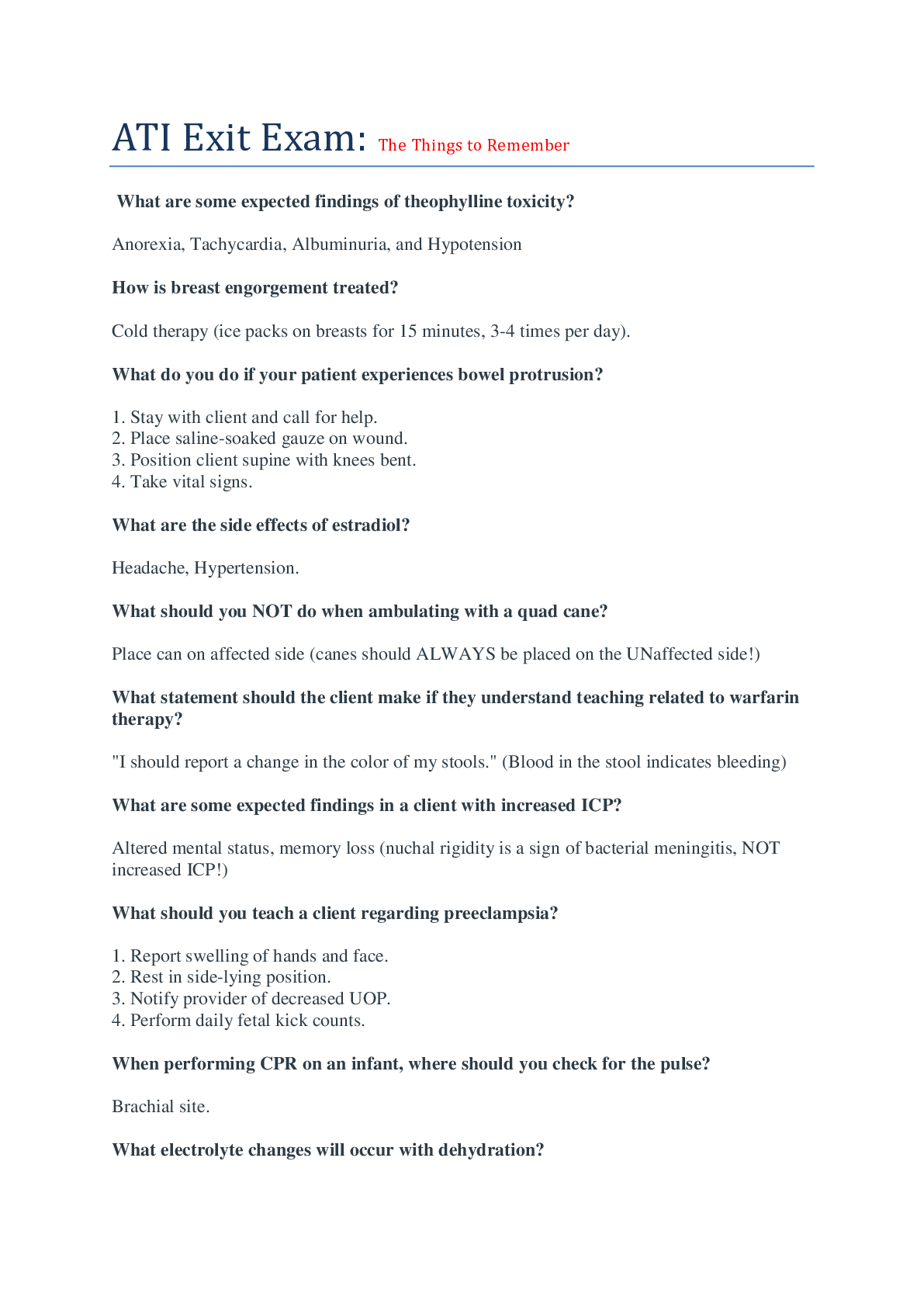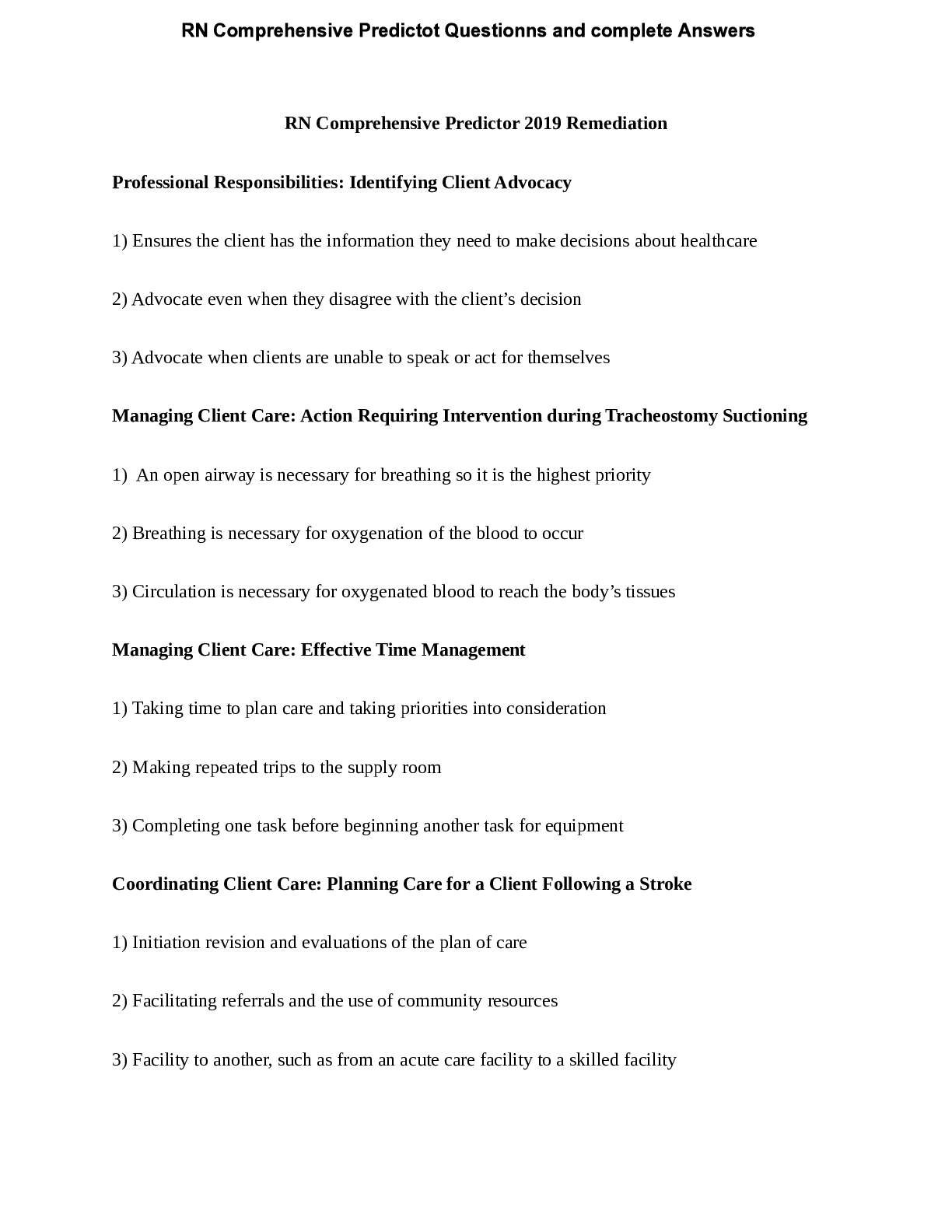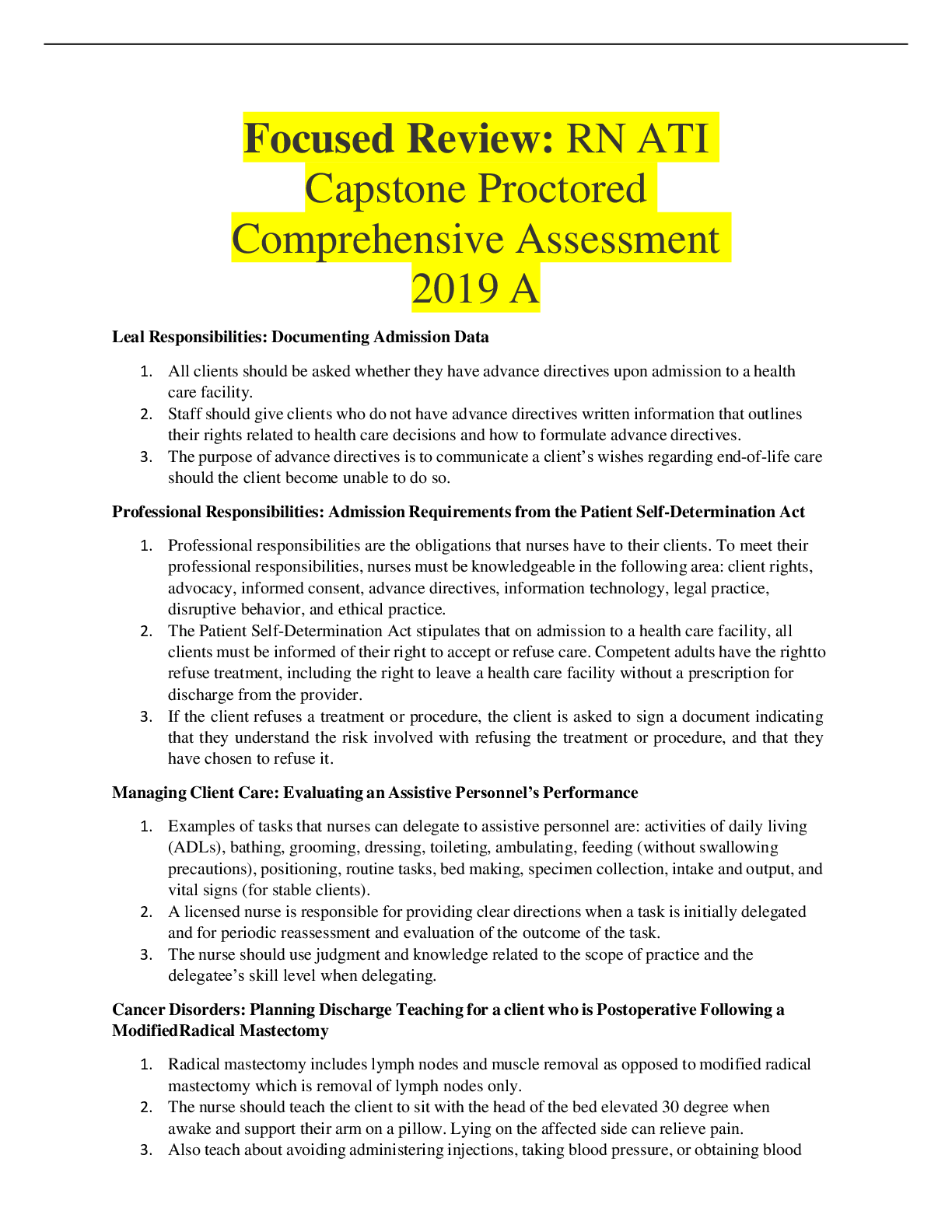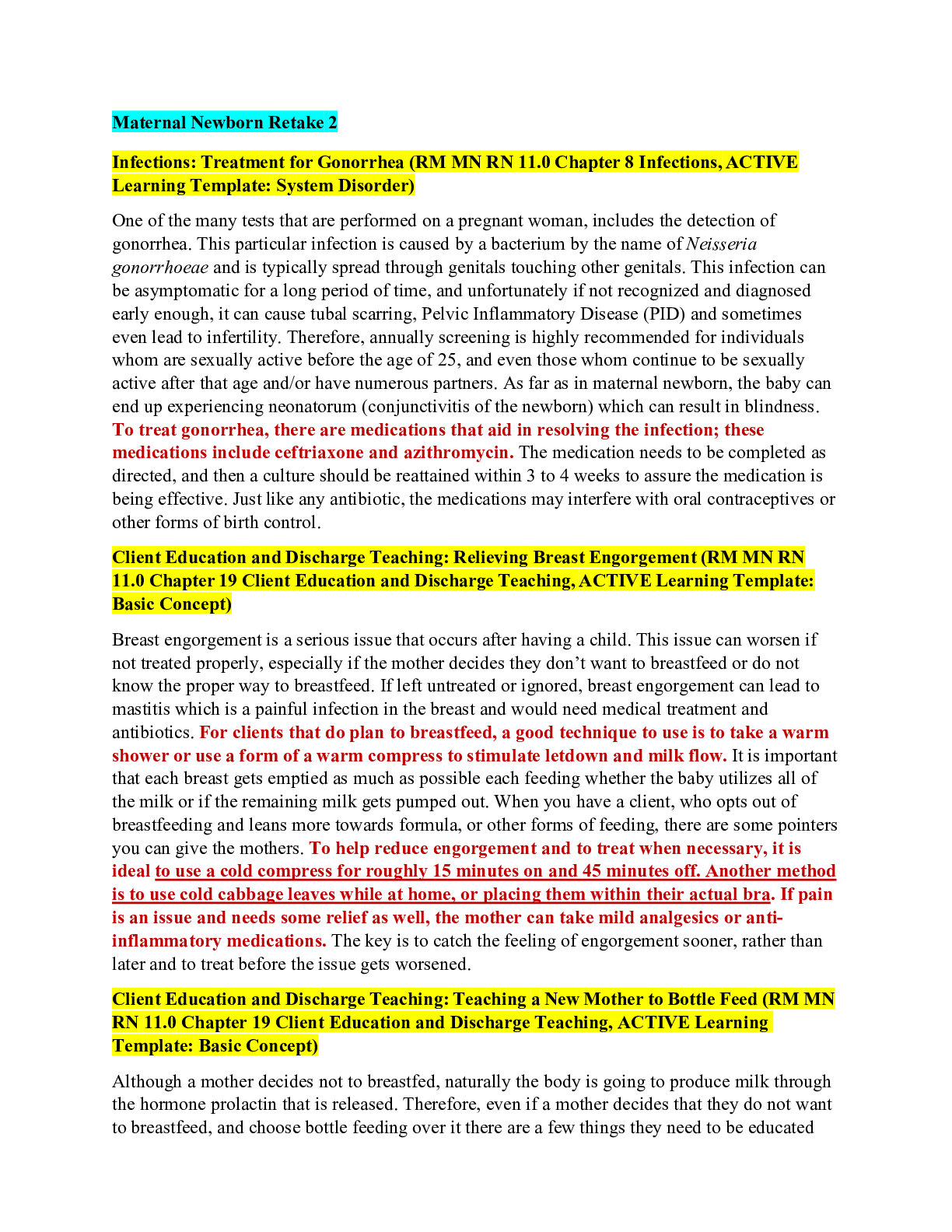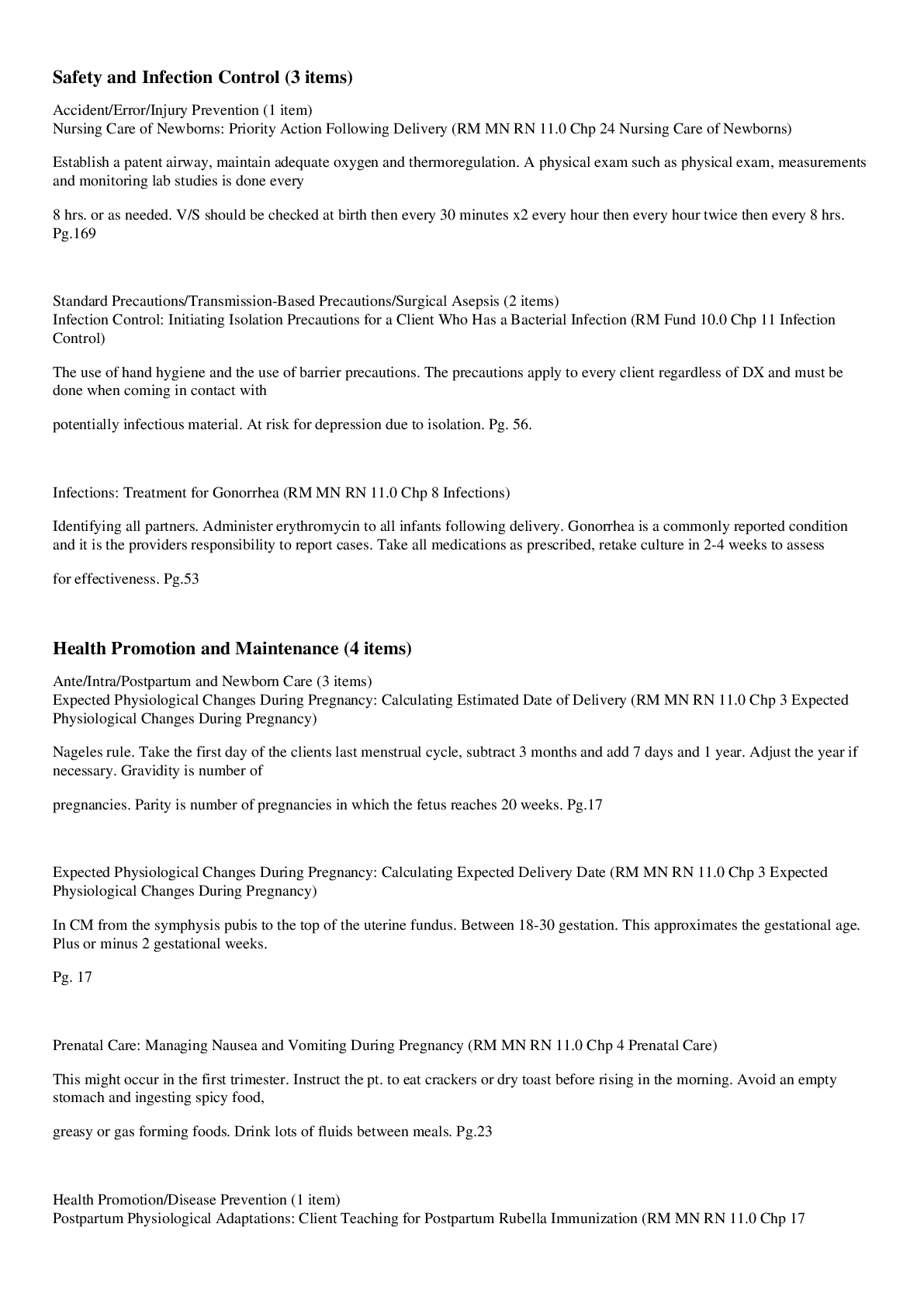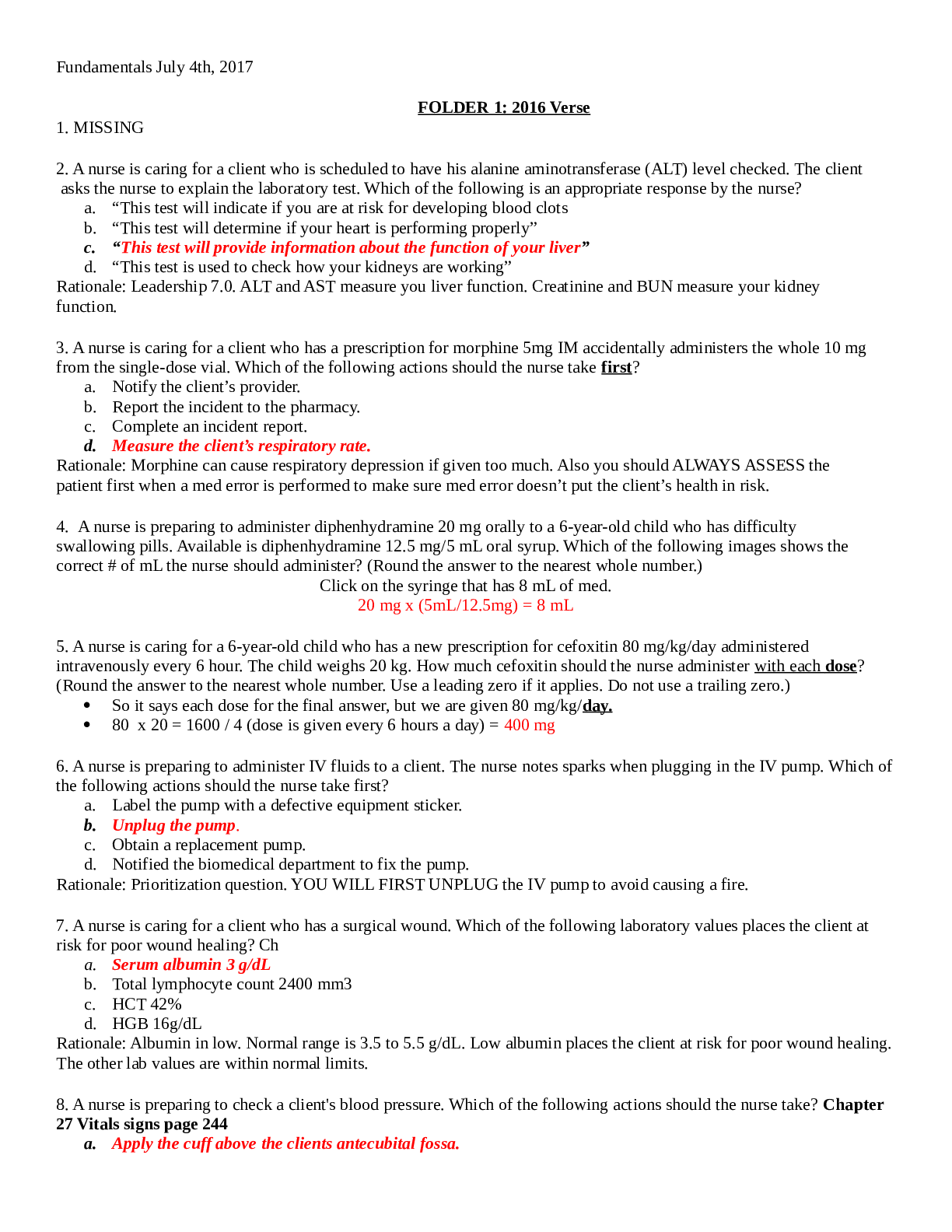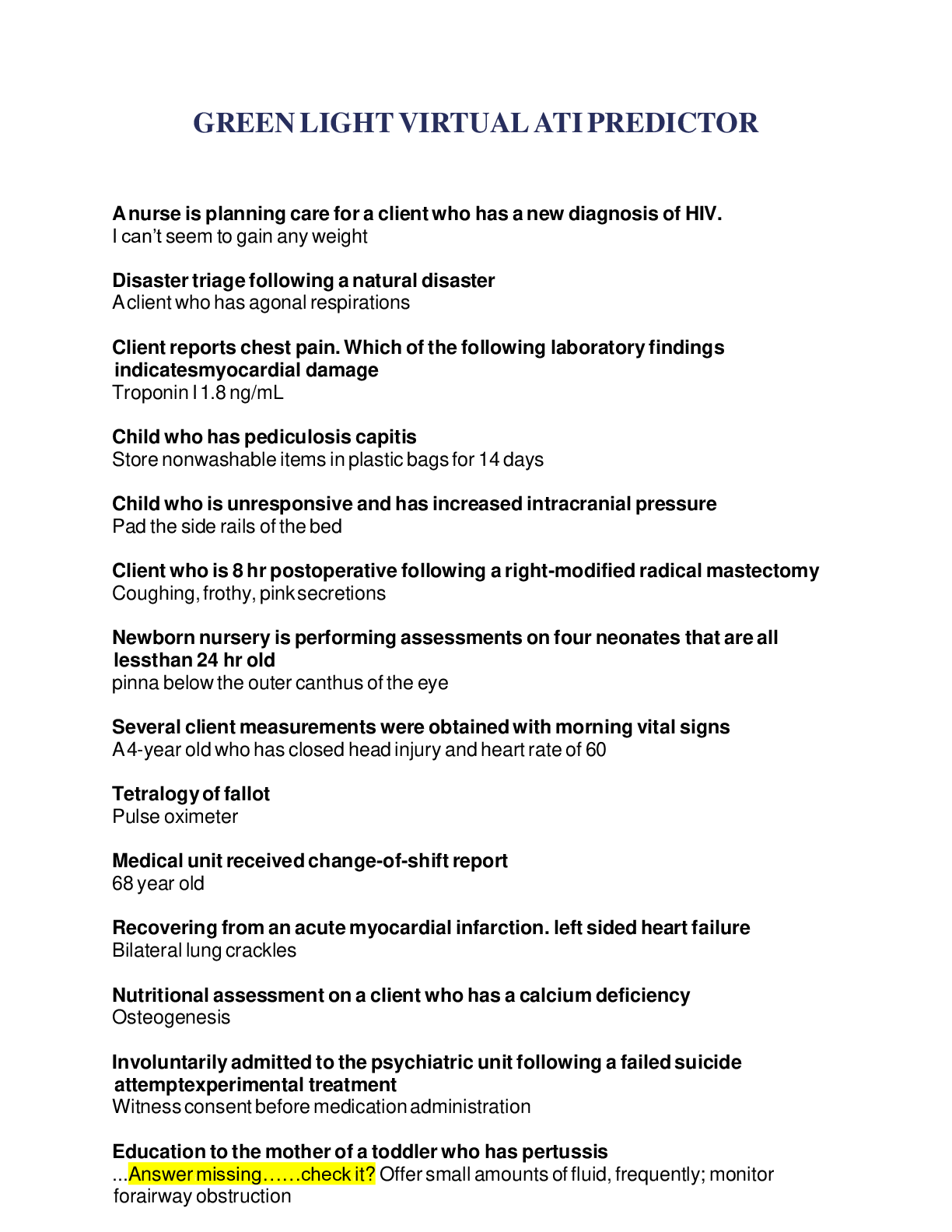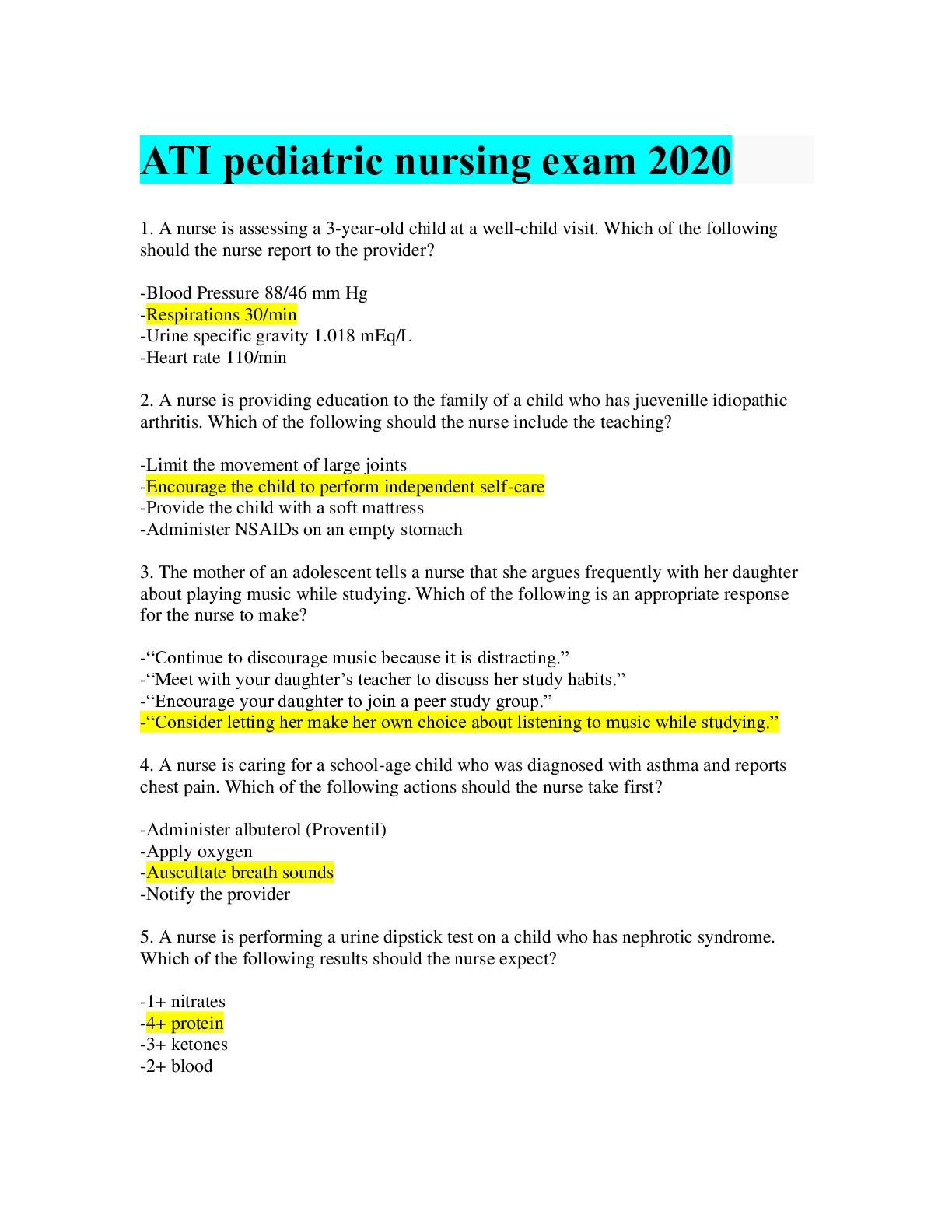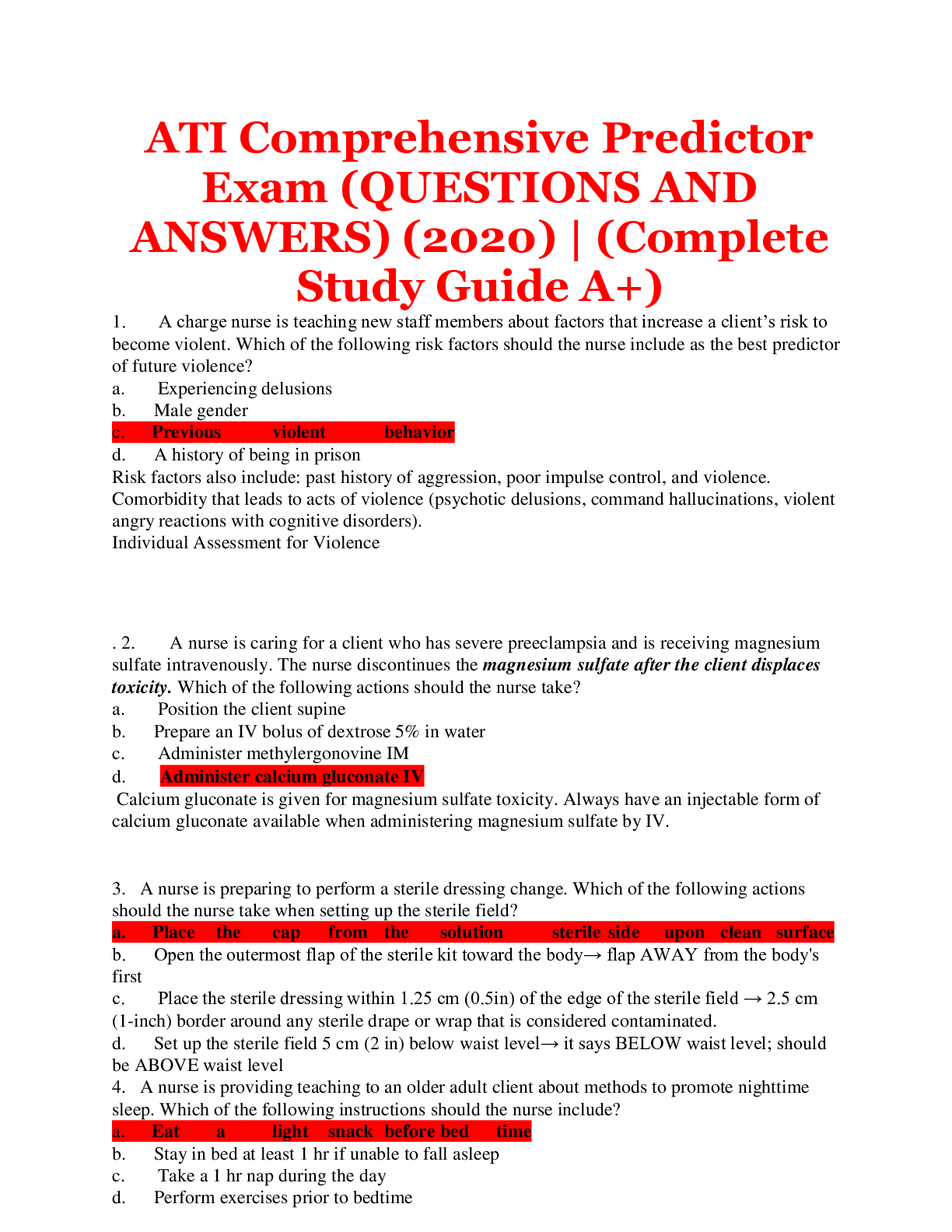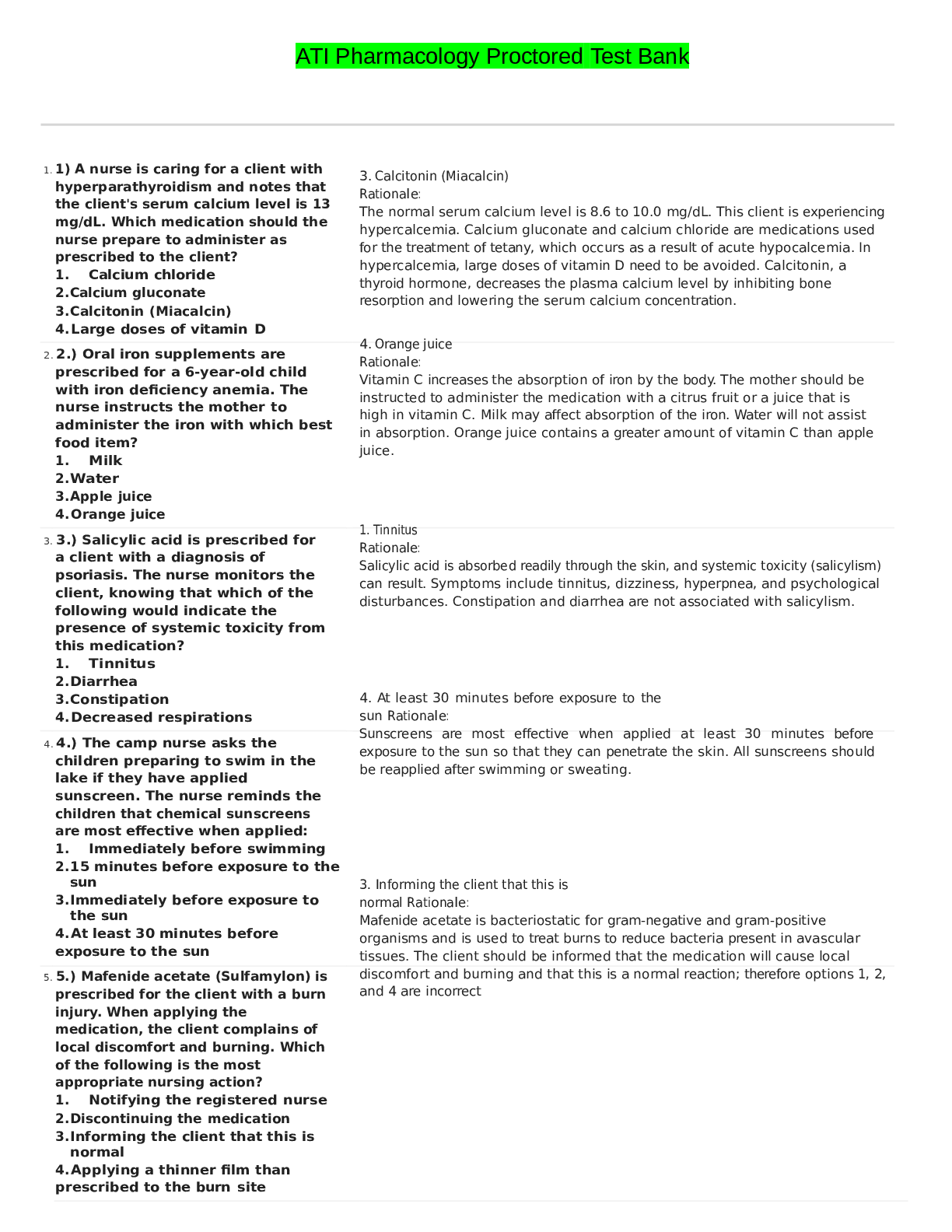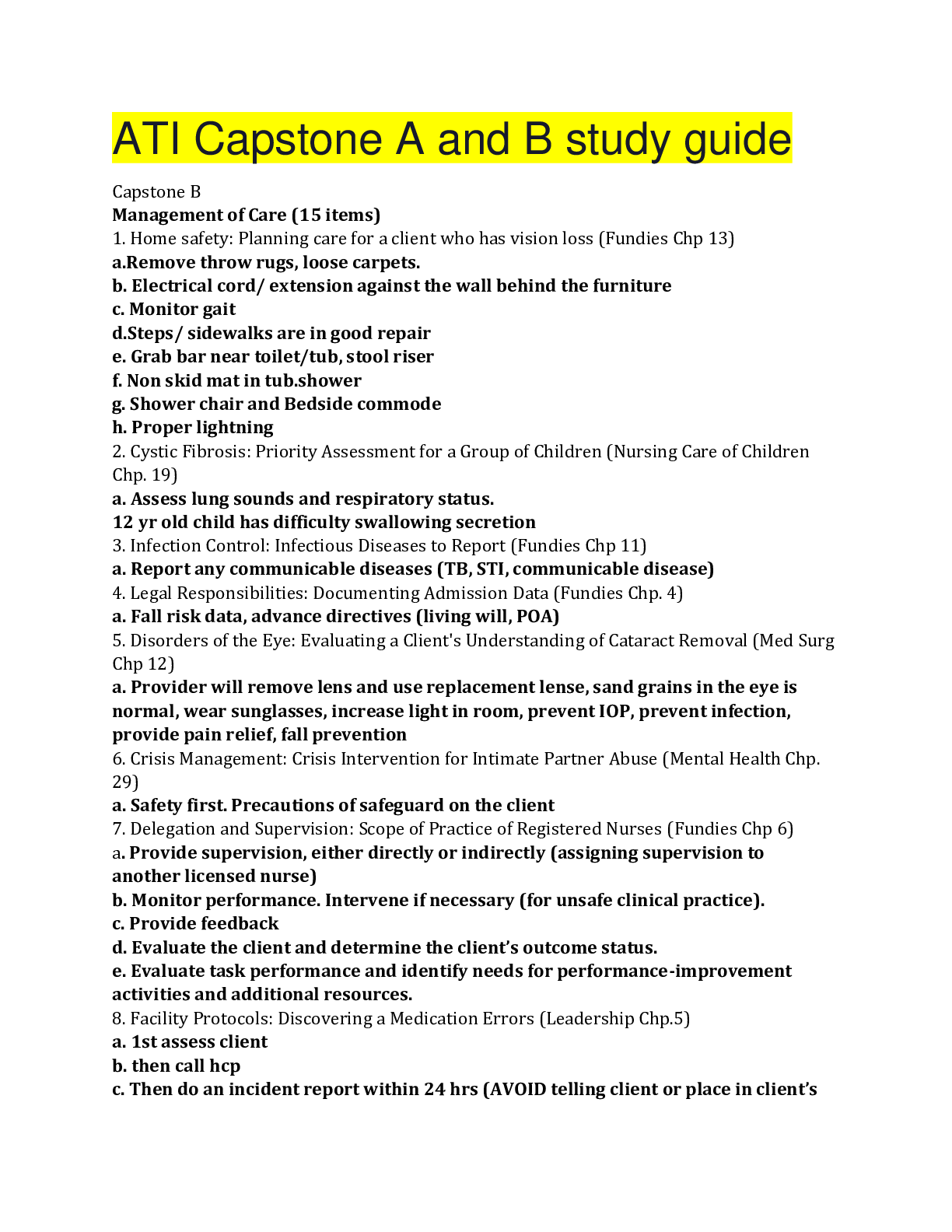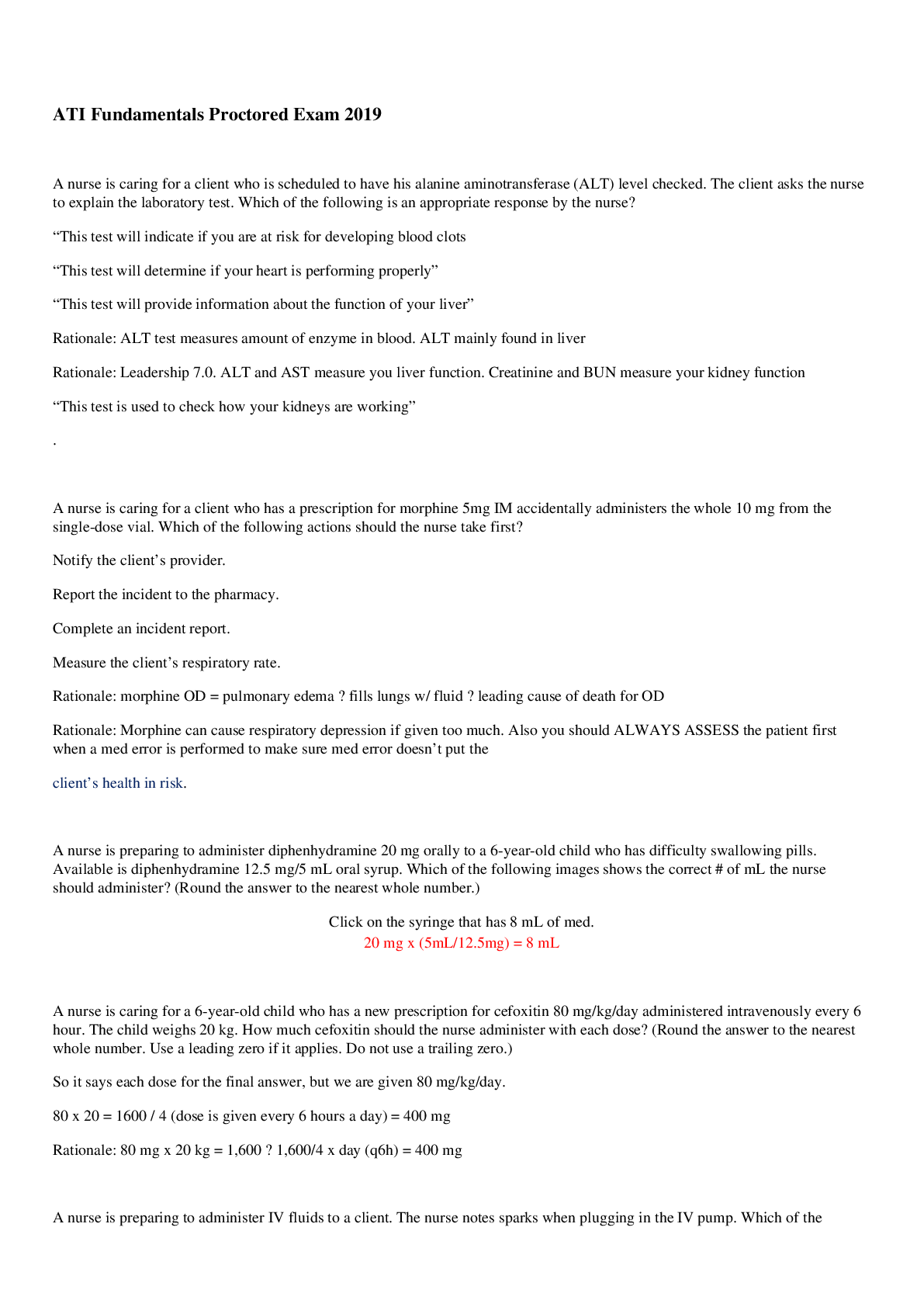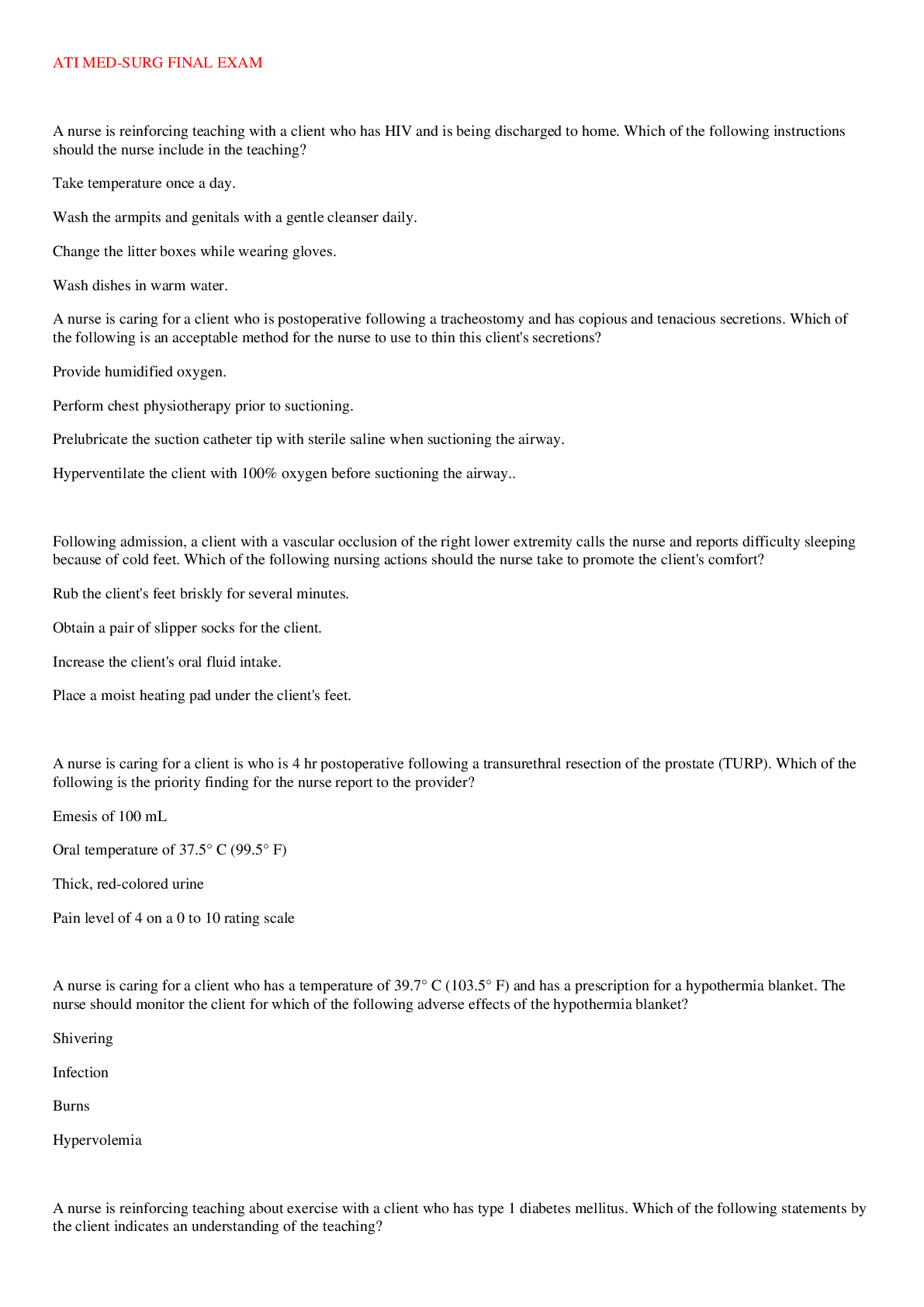*NURSING > QUESTIONS and ANSWERS > ATI Comprehensive Predictor_Study Guide. This 72 page study guide features the most and commonly tes (All)
ATI Comprehensive Predictor_Study Guide. This 72 page study guide features the most and commonly tested areas in ATI Comprehensive Preditor Exams. Has an easy and quick to read layout and content organisation.
Document Content and Description Below
ATI Comprehensive Predictor Study Guide 1. Professional Responsibilities: Durable Power of Attorney for Health Care A. A durable power of attorney for health care/health care proxy is a ... legal document that designates a health care surrogate, who is an individual authorized to make healthcare decisions for a client who is unable. B. The person who serves in the role of health care surrogate to make decisions for the client should be very familiar with the client’s wishes. C. Living wills can be difficult to interpret, especially in the face of unexpected circumstances. A durable power of attorney for health care, as an adjunct to a living will, can be a more effective way of ensuring that the client’s decisions about health care are honored. 2. Professional Responsibilities: Educating Staff About Client Advocacy A. As advocates, nurses must ensure that clients are informed of their rights and have adequate information on which to base health care decisions. B. Nurses must be careful to assist clients with making health care decisions and not direct or control their decisions. C. Nurses mediate on the client’s behalf when the actions of others are not in the client’s best interest or changes need to be made in the plan of care. D. Do not need a lawyer E. Situations in which nurses might need to advocate o End‑of‑life decisions o Access to health care o Protection of client privacy o Informed consent o Substandard practice NURSING ROLE IN ADVANCE DIRECTIVES A. Providing written information regarding advance directives B. Documenting the client’s advance directives status C. Ensuring that advance directives are current and reflective of the client’s current decisions D. Recognizing that the client’s choice takes priority when there is a conflict between the client and family, or between the client and the provider E. Informing all members of the health care team of the client’s advance directives 3. Professional responsibilities: Client Advocacy 4. Cultural and Spiritual Nursing Care: Working With an Interpreter A. Use only a facility‑approved medical interpreter. Do not use the client’s family or friends, or a nondesignated employee to interpret. B. Inform the interpreter about the reason for and the type of questions that will be asked, the expected response (brief or detailed), and with whom to converse. C. Allow time for the interpreter and the family to be introduced and become acquainted before starting the interview. D. Ask one question at a time E. Direct the questions to the family, not to the interpreter. Use lay terminology F. Do not interrupt the interpreter, the client, or the family as they talk. Following the interview, ask the interpreter for any additional thoughts about the interview and the client’s and family’s responses, both verbal and nonverbal. 5. Overview of Community Health Nursing: Adhering to Ethical Principals A. Respect for autonomy o Allow individuals to select actions to fulfill their goals B. Nonmaleficence o No harm is done when applying standards of care C. Beneficence o Maximize possible benefits and minimize possible harms D. Distributive justice o Fair distribution of the benefits and burden in society is based on the needs and contributions of its members 6. Cultural and spiritual nursing care: Appropriate use of an Interpreter 7. Managing Client Care: Assigning a Task to an Assistive Personnel TO AP A. Activities of daily living (ADLs) B. Bathing C. Grooming D. Dressing E. Toileting F. Ambulating G. Feeding (without swallowing precautions) H. Positioning I. Routine tasks J. Bed making K. Specimen collection L. Intake and output M. Vital signs (for stable clients) N. Postmortem care 8. Managing Client Care: Decision Making About Delegation A. Use nursing judgment and knowledge related to the scope of practice and delegate’s skill level when delegating. B. Use the five rights of delegation o What tasks the nurse delegate (right task) o Under what circumstances (right circumstance) o To whom (right person) o What information should be communicated (right direction/communication) o How to supervise/evaluate (right supervision/evaluation) 9. Managing Client Care: Delegating Tasks to a Licensed Practical Nurse A. Monitoring findings (as input to the RN ’s ongoing assessment) B. Reinforcing client teaching from a standard care plan C. Performing tracheostomy care D. Suctioning E. Checking NG tube patency F. Administering enteral feedings G. Inserting a urinary catheter H. Administering medication (excluding IV medication in some states) I. Don’t delegate what you can EAT- evaluate, assess, teach. No blood, no TPN, or initial assessment 10. Managing Client Care: Delegating Tasks to Assistive Personnel: Considerations for selection: A. Education, training, and experience B. Knowledge and skill to perform the task C. Level of critical thinking required to complete the task D. Ability to communicate with others as it pertains to the task E. Demonstrated competence F. The delegate's culture 11. Managing Client Care: Effective Time Management Time savers A. Documenting nursing interventions as soon as possible after completion to facilitate accurate and thorough documentation B. Grouping activities that are to be performed on the same client or are in close physical proximity to prevent unnecessary walking C. Estimating how long each activity will take and planning accordingly D. Mentally envisioning the procedure to be performed and gathering all equipment prior to entering the client’s room E. Taking time to plan care and taking priorities into consideration F. Delegating activities to other staff when client care workload is beyond what can be handled by one nurse G. Enlisting the aid of other staff when a team approach is more efficient than an individual approach H. Completing more difficult or strenuous tasks when energy level is high I. Avoiding interruptions and graciously but assertively saying “no” to unreasonable or poorly timed requests for help J. Setting a realistic standard for completion of care and level of performance within the constraints of assignment and resources K. Completing one task before beginning another task L. Breaking large tasks into smaller tasks to make them more manageable M. Using an organizational sheet to plan care N. Using breaks to socialize with staff Time wasters A. Documenting at the end of the shift all client care provided and assessments done B. Making repeated trips to the supply room for equipment C. Providing care as opportunity arises regardless of other responsibilities D. Missing equipment when preparing to perform a procedure E. Failing to plan or managing by crisis F. Being reluctant to delegate or under delegating G. Not asking for help when needed or trying to provide all client care independently H. Procrastinating: delaying time‑consuming, less desirable tasks until late in the shift I. Agreeing to help other team members with lower priority tasks when time is already compromised J. Setting unrealistic standards for completion of care and level of performance within constraints of assignment and resources K. Starting several tasks at once and not completing tasks before starting others L. Not addressing low level of skill competency, increasing time on task M. Providing care without a written plan N. Socializing with staff during client care time 12. Managing Client Care: Organizing Workload to Manage Time Effectively TIME MANAGEMENT A. Organize care according to client care needs and priorities. B. What must be done immediately (administration of analgesic or antiemetic, assessment of unstable client)? C. What must be done by a specific time to ensure client safety, quality care, and compliance with facility policies and procedures (routine medication administration, vital signs, blood glucose monitoring)? D. What must be done by the end of the shift (ambulation of the client, discharge and/or discharge teaching, dressing change)? o What can the nurse delegate? o What tasks can only the RN perform? E. What client care responsibilities can the nurse delegate to other health care team members, such as practical nurses (PNs) and assistive personnel (APs)? F. Use time‑saving strategies and avoid time wasters. (1.2) G. Good time management o Facilitates greater productivity. o Decreases work‑related stress. o Helps ensure the provision of quality and appropriately prioritized client care. o Enhances satisfaction with care provided. H. Poor time management I. Impairs productivity. J. Leads to feelings of being overwhelmed and stressed. K. Increases omission of important tasks. L. Creates dissatisfaction with care provided. Time management is a cyclic process. A. Time initially spent developing a plan will save time later and help to avoid management by crisis. B. Set goals and plan care based on established priorities and thoughtful utilization of resources. C. Complete one client care task before beginning the next, starting with the highest priority task. D. Reprioritize remaining tasks based on continual reassessment of client care needs. E. At the end of the day, perform a time analysis and determine if time was used wisely. TIME MANAGEMENT AND SELF‑CARE A. Take time for yourself. B. Schedule time for breaks and meals. C. Take physical and mental breaks from work and the unit. 13. Managing Client Care: Responding to an Incomplete Delegated Task SUPERVISION A. Occurs after delegation. A supervisor oversees a staff member’s performance of delegated activities and determines if: B. Completion of tasks is on schedule. C. Performance was at a satisfactory level. D. Unexpected findings were documented and reported. E. Assistance is needed to complete assigned tasks in a timely manner. Assignment should be reevaluated and possibly changed 14. Managing Client Care: Utilizing the Five Rights of Delegation ********************************** CONTINUED IN THE ATTACHMENT *********************************** [Show More]
Last updated: 1 year ago
Preview 1 out of 72 pages
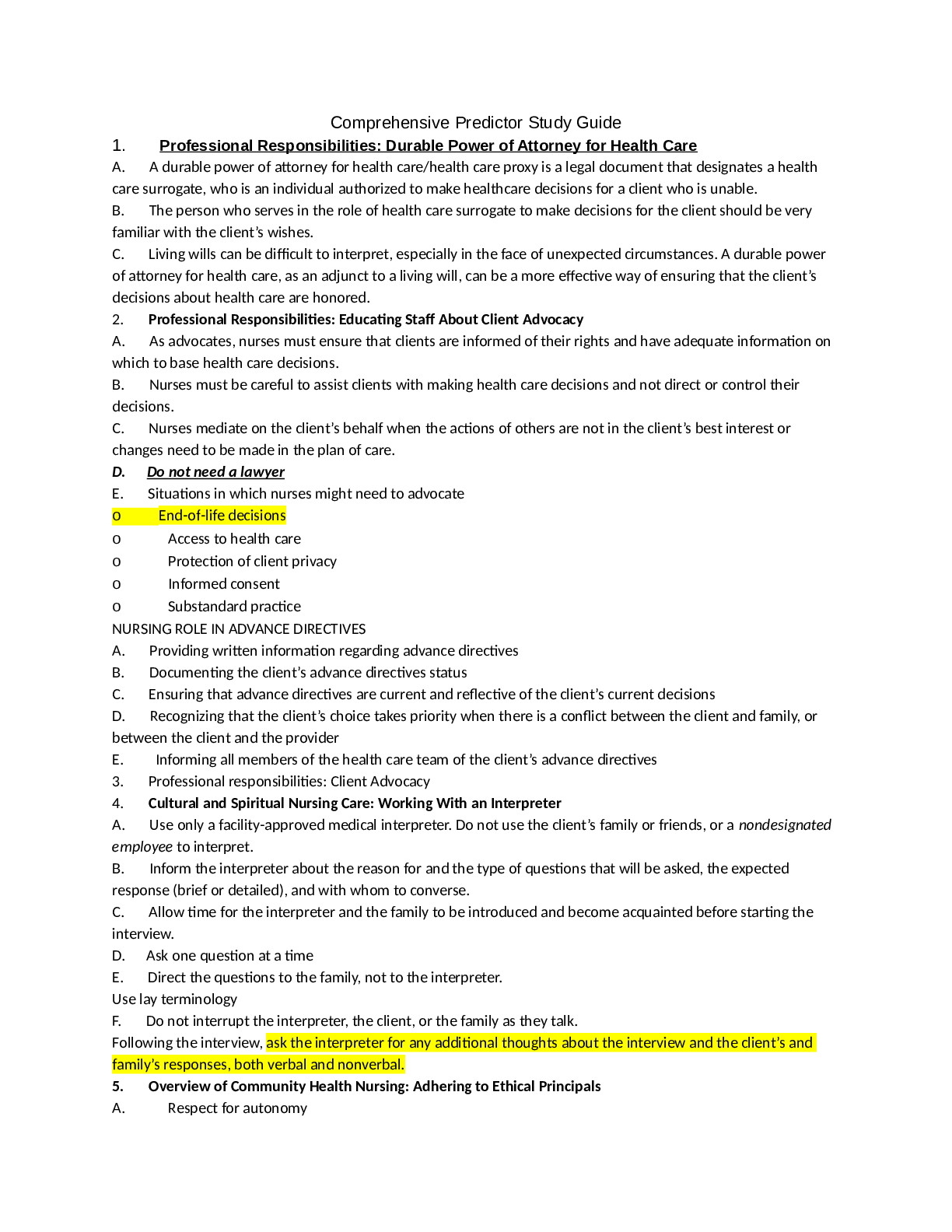
Reviews( 0 )
Document information
Connected school, study & course
About the document
Uploaded On
Mar 02, 2021
Number of pages
72
Written in
Additional information
This document has been written for:
Uploaded
Mar 02, 2021
Downloads
0
Views
81



